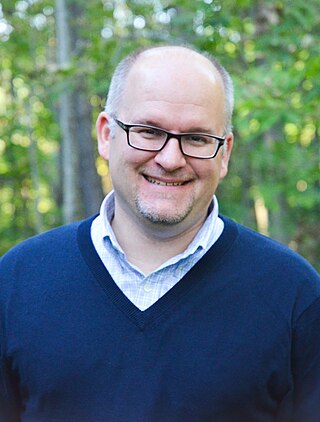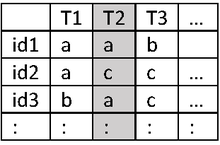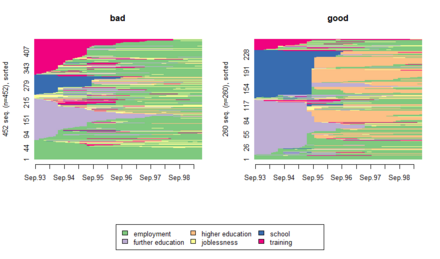
Social network analysis (SNA) is the process of investigating social structures through the use of networks and graph theory. It characterizes networked structures in terms of nodes and the ties, edges, or links that connect them. Examples of social structures commonly visualized through social network analysis include social media networks, meme spread, information circulation, friendship and acquaintance networks, peer learner networks, business networks, knowledge networks, difficult working relationships, collaboration graphs, kinship, disease transmission, and sexual relationships. These networks are often visualized through sociograms in which nodes are represented as points and ties are represented as lines. These visualizations provide a means of qualitatively assessing networks by varying the visual representation of their nodes and edges to reflect attributes of interest.

Qualitative research is a type of research that aims to gather and analyse non-numerical (descriptive) data in order to gain an understanding of individuals' social reality, including understanding their attitudes, beliefs, and motivation. This type of research typically involves in-depth interviews, focus groups, or observations in order to collect data that is rich in detail and context. Qualitative research is often used to explore complex phenomena or to gain insight into people's experiences and perspectives on a particular topic. It is particularly useful when researchers want to understand the meaning that people attach to their experiences or when they want to uncover the underlying reasons for people's behavior. Qualitative methods include ethnography, grounded theory, discourse analysis, and interpretative phenomenological analysis. Qualitative research methods have been used in sociology, anthropology, political science, psychology, communication studies, social work, folklore, educational research, information science and software engineering research.

Conversation analysis (CA) is an approach to the study of social interaction that empirically investigates the mechanisms by which humans achieve mutual understanding. It focuses on both verbal and non-verbal conduct, especially in situations of everyday life. CA originated as a sociological method, but has since spread to other fields. CA began with a focus on casual conversation, but its methods were subsequently adapted to embrace more task- and institution-centered interactions, such as those occurring in doctors' offices, courts, law enforcement, helplines, educational settings, and the mass media, and focus on multimodal and nonverbal activity in interaction, including gaze, body movement and gesture. As a consequence, the term conversation analysis has become something of a misnomer, but it has continued as a term for a distinctive and successful approach to the analysis of interactions. CA and ethnomethodology are sometimes considered one field and referred to as EMCA.
In social sciences and other domains, representative sequences are whole sequences that best characterize or summarize a set of sequences. In bioinformatics, representative sequences also designate substrings of a sequence that characterize the sequence.

Computational sociology is a branch of sociology that uses computationally intensive methods to analyze and model social phenomena. Using computer simulations, artificial intelligence, complex statistical methods, and analytic approaches like social network analysis, computational sociology develops and tests theories of complex social processes through bottom-up modeling of social interactions.

Discourse analysis (DA), or discourse studies, is an approach to the analysis of written, spoken, or sign language, including any significant semiotic event.

The sociology of scientific knowledge (SSK) is the study of science as a social activity, especially dealing with "the social conditions and effects of science, and with the social structures and processes of scientific activity." The sociology of scientific ignorance (SSI) is complementary to the sociology of scientific knowledge. For comparison, the sociology of knowledge studies the impact of human knowledge and the prevailing ideas on societies and relations between knowledge and the social context within which it arises.
In epistemology, and more specifically, the sociology of knowledge, reflexivity refers to circular relationships between cause and effect, especially as embedded in human belief structures. A reflexive relationship is multi-directional when the causes and the effects affect the reflexive agent in a layered or complex sociological relationship. The complexity of this relationship can be furthered when epistemology includes religion.
The life course approach, also known as the life course perspective or life course theory, refers to an approach developed in the 1960s for analyzing people's lives within structural, social, and cultural contexts. It views one's life as a socially sequenced timeline and recognizes the importance of factors such as generational succession and age in shaping behavior and career. Development does not end at childhood, but instead extends through multiple life stages to influence life trajectory.

Michael Burawoy is a British sociologist working within Marxist social theory, best known as the leading proponent of public sociology and the author of Manufacturing Consent: Changes in the Labor Process Under Monopoly Capitalism—a study on the sociology of industry that has been translated into a number of languages.
Optimal matching is a sequence analysis method used in social science, to assess the dissimilarity of ordered arrays of tokens that usually represent a time-ordered sequence of socio-economic states two individuals have experienced. Once such distances have been calculated for a set of observations classical tools can be used. The method was tailored to social sciences from a technique originally introduced to study molecular biology sequences. Optimal matching uses the Needleman-Wunsch algorithm.

Geoffrey Nigel Gilbert is a British sociologist and a pioneer in the use of agent-based models in the social sciences. He is the founder and director of the Centre for Research in Social Simulation, author of several books on computational social science, social simulation and social research and past editor of the Journal of Artificial Societies and Social Simulation (JASSS), the leading journal in the field.

A social network is a social structure made up of a set of social actors, sets of dyadic ties, and other social interactions between actors. The social network perspective provides a set of methods for analyzing the structure of whole social entities as well as a variety of theories explaining the patterns observed in these structures. The study of these structures uses social network analysis to identify local and global patterns, locate influential entities, and examine network dynamics.

Stephen Lawrence Morgan is a Bloomberg Distinguished Professor of Sociology and Education at the Johns Hopkins University School of Arts and Sciences and Johns Hopkins School of Education. A quantitative methodologist, he is known for his contributions to quantitative methods in sociology as applied to research on schools, particularly in models for educational attainment, improving the study of causal relationships, and his empirical research focusing on social inequality and education in the United States.
Paul D. Allison is an American statistician and sociologist. He is the President of Statistical Horizons and Professor Emeritus of Sociology at the University of Pennsylvania.
Angela Dale is a British social scientist and statistician whose research has involved the secondary analysis of government survey data, and the study of women in the workforce. Formerly Deputy Director of the Social Statistics Research Unit of City, University of London, and Professor of Quantitative Research and Director of the Cathie Marsh Centre for Census and Survey Research at the University of Manchester, she is now a professor emerita at Manchester.
Life course research is an interdisciplinary field in the social and behavioral sciences. Developed during the 1960s, it aims to study human development over the entire life span. As such, it brings together aspects of human development that had previously only been studied separately. In the 1970s, scholars first started to commonly refer to their field as "life course research". The field includes research conceptualizing the life course as one of many different concepts, including developmental processes, cultural constructs, and demographic accounts.

Gilbert Ritschard is a Swiss statistician specialized in quantitative methods for the social sciences and in the analysis of longitudinal data describing life courses. He is Professor Emeritus at the University of Geneva. He earned a Ph.D. in Econometrics and Statistics at the University of Geneva in 1979. His main contributions are in sequence analysis. He initiated and led the SNFS project that developed the TraMineR R toolkit for sequence analysis. He is one of the founders of the Sequence Analysis Association, which he served as first president.

Video Data Analysis (VDA) is a curated multi-disciplinary collection of tools, techniques, and quality criteria intended for analyzing the content of visuals to study driving dynamics of social behavior and events in real-life settings. It often uses visual data in combination with other data types. VDA is employed across the social sciences such as sociology, psychology, criminology, business research, and education research.
Jeylan T. Mortimer is an American sociologist. She is Professor Emeritus at the University of Minnesota, where she founded the Life Course Center and served as its Director from 1986 to 2006.















